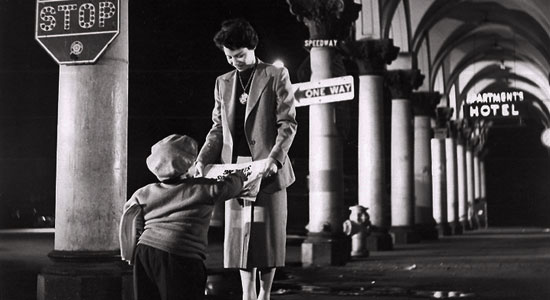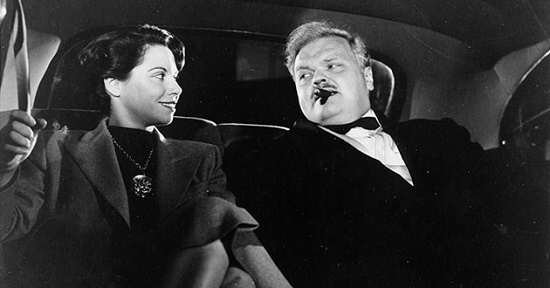Dementia (1955 aka Daughter of Horror 57min)
Director/Writer – John Parker
Cinematography – William C. Thompson
Music – George Antheil
I’m sure the 50’s hep-cats and ‘seasoned’ film-noir enthusiasts among you will already know of this film. Nevertheless for a greenhorn like myself, I find it damn near impossible to simply watch something like Dementia and not say a few words about it; even if it is just to confirm, through the reader’s feedback, whether or not I’m clueless as to what defines art, missing the point all together, or that I’m simply a weirdo!
Dementia (or as it was later changed to: Daughter of Horror) is a very stylish and strange short film (ca. 57 mins) from deep within the archives of the 50’s avant-garde b-movies. In fact, most movie-buffs may know it more as the film being watched in the cinema, during that famous scene in the 50’s cult-classic, The Blob, rather than a movie of any cinematic significance. It is believed that it was Jack H. Harris, producer of The Blob, who eventually bought the film from Parker and added the narration, renaming the movie Daughter Of Horror. This would make complete sense as Harris could then feature it in The Blob without hindrance. And the added narration, which can be heard in the background during The Blob’s famous cinema scene, serves well to intensify the suspense as The Blob approaches the screaming kids. Even the name ‘Daughter of Horror’ seems like it was added with The Blob in mind, as a poster for ‘Daughter of Horror’, and not ‘Dementia’, can also be seen for a split second during that scene.
This mostly ‘silent’, black and white film opens with a high-angle, night-time shot of a neon-lit street, when, after being invited by the narrator to come with him, ”into the tormented, haunted, half-lit night of the insane”, we are drawn slowly through an open window into a young lady’s bedroom, á la Orson Welles. On the bed lies the sleeping beauty squirming and clutching her bed-sheet tightly. Is she having a nightmare… or an erotic dream? Of this the audience is kept guessing, and from here on in, the tone is set for a private view into the young lady’s twisted and perverse psyche. After wakening from her dream-state, she takes a flick-knife from the drawer and ventures out onto the streets, where she encounters all forms of low-lives, debauchery and sexual depravity, all tied together by hallucination sequences that even have the viewer questioning ‘what is reality/ what is fantasy?’.
Although the film has strong ‘noirish’ elements (lighting, street scenes, atmosphere etc), it’s intrinsically expressionist in nature. Very reminiscent of works by German expressionist film-maker, Robert Wiene (The Cabinet of Dr Caligari). Though I’m sure French Impressionist aficionados will argue with this. And they would have every right to, as the film (whether intentional or not) also pays homage to the early, experimental works of the great Luis Buñuel. Either way, this will put into context for you, that this isn’t your average Sunday-afternoon matinee, but rather a performance art concept masqueraded as a film-noir. It also fits into the horror bracket. Although as a horror it struggles to hit its mark. Throw in some very jazzy underground scenes featuring the legendary West Coast jazz ensemble, Shorty Rogers and His Giants, (which along with the narrators voice and a some sound effects are the only sounds you hear, as the film has no spoken dialogue from the actors whatsoever) and you have yourselves a compelling and ambitious ‘Art-Noir’ film (eventually favouring this term over ‘Beatnik-Noir’!) that needs to be seen to be appreciated.
For those brave enough to give Dementia a chance, and once you get over the initial feeling that your watching an Ed Wood movie, you’ll be pleasantly surprised as to how skilfully director John Parker manages to pull off a project which, on paper, you’d swear was doomed from the start. Personally, I loved Dementia. But like I said at the beginning of this review, maybe I’m just a weirdo!



A very cogent analysis of a genuinely one-of-a-kind movie. According to what I’ve read, it started off as a dream/nightmare of Parker’s secretary, Adrienne Barrett; she told him about it the next morning; he thought it’d be fun to make an experimental short out of it, and she agreed to play the central role; the rest is history.
The soundtrack also contains, by the way, some non-verbal vocalizations; believe it or not, these were done by the redoubtable Marni Nixon!
What’s always puzzled me is how such a low-budget, amateur (even if not amateurish) production could get itself a George Antheil soundtrack.
LikeLike
Allan: Great to see you posting here in these hallowed halls of film noir! Well, it is a fact that my exposure to this particular film has been restricted to that celebrated movie house sequence in THE BLOB. And for some reason I always confuse the name of this film and Francis Ford Coppola’s first film, an eerie and atmospheric excursion into horror titled DEMENTIA 13. The expressionistic look of the film that you vouch for and the comparison with Weine’s CABINET make it a most intriguing work to check out. I echo John Grant’s observation of Antheil, whose other music has ravished me in various degrees.
But really a fantastic review here Allan.
LikeLike
@realthog, That story about the secretary wouldn’t surprise me in the slightest. This movie is probably shrouded in all kinds of wacky stories. If I had the time I’d love to investigate it more as I’m sure you could right a small book on this film alone, or perhaps even a movie, in the same vain Ed Wood. I’m glad you liked my piece, thanks for the feedback.
LikeLike
@ Sam. I very pleased you like my work as I’m a big fan of Wonders in The Dark. It’s almost a shame that you had to read my article before watching Dementia, as it’s that element of surprise when you watch first Dementia without knowing anything about it in advance (as was the case with me), that really catches you off-guard and makes you want to know about this little gem.
I mention Caligari, but I’m sure if I delved a little deeper into Dementia’s background, I could make the French Impressionism angle stick a little more. But perhaps we’ll resume that conversation once you’ve had a chance to view Dementia yourself.
I’ve seen only snippets of Dementia 13. I didn’t even know it was by Coppola! So there you go, here’s where we come to learn new things.
LikeLike